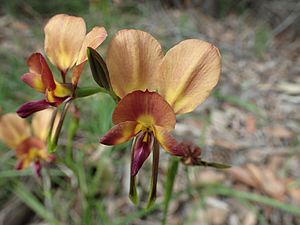Dunsborough donkey orchid facts for kids
Quick facts for kids Dunsborough donkey orchid |
|
|---|---|
 |
|
| Diuris jonesii growing near Ellen Brook Road in the Leeuwin-Naturaliste National Park | |
| Scientific classification | |
| Genus: |
Diuris
|
| Species: |
jonesii
|
The Diuris jonesii, commonly called the Dunsborough donkey orchid, is a special kind of orchid. It is found only in the south-west part of Western Australia. This means it is endemic to that area. Its flowers are large and have colors like yellow, brown, and a purplish-pink (mauve). You can find this orchid growing near the coast between the towns of Dunsborough and Augusta.
Contents
What Does It Look Like?
The Dunsborough donkey orchid is a tuberous plant. This means it grows from a special underground storage part called a tuber. It also lives for more than two years. It is a herb, so it has soft stems, not woody ones like a tree. This orchid usually grows to be about 25 to 40 centimeters (10 to 16 inches) tall.
It has two or three leaves that grow from its base. Each leaf is about 10 to 30 centimeters (4 to 12 inches) long and 0.5 to 1.2 centimeters (0.2 to 0.5 inches) wide.
The plant produces between two and eight flowers. These flowers are yellow, mauve, and brown. They are about 4 to 5 centimeters (1.6 to 2 inches) long and 2 to 3.5 centimeters (0.8 to 1.4 inches) wide.
- The top part of the flower, called the dorsal sepal, stands straight up.
- The side sepals are narrow and hang downwards, sometimes crossing each other.
- The petals are long and thin.
- The labellum (the orchid's special lip petal) has side parts that spread out. Its center part is wide and can be flat or folded.
This orchid looks a bit like the giant donkey orchid, D. amplissima. However, the Dunsborough donkey orchid has smaller flowers that are not as brightly colored. It also grows closer to the coast. You can see these orchids flowering from late September to October.
How It Got Its Name
The Diuris jonesii was officially described in 2013. This means it was given its scientific name and details were written down. The scientists who described it were Christopher French and Garry Brockman. They found a sample of the plant at Cape Naturaliste.
The scientific name jonesii was chosen to honor a botanist named David Jones.
Where It Lives
The Dunsborough donkey orchid grows in areas with shrubs and trees. It prefers places close to the coast. You can find it between Dunsborough and Augusta. These areas are part of the Jarrah Forest, Swan Coastal Plain, and Warren regions.
Is It Protected?
The Western Australian Government's Department of Parks and Wildlife has looked at the Dunsborough donkey orchid. They have classified it as "not threatened." This means it is not currently in danger of disappearing.
Images for kids


